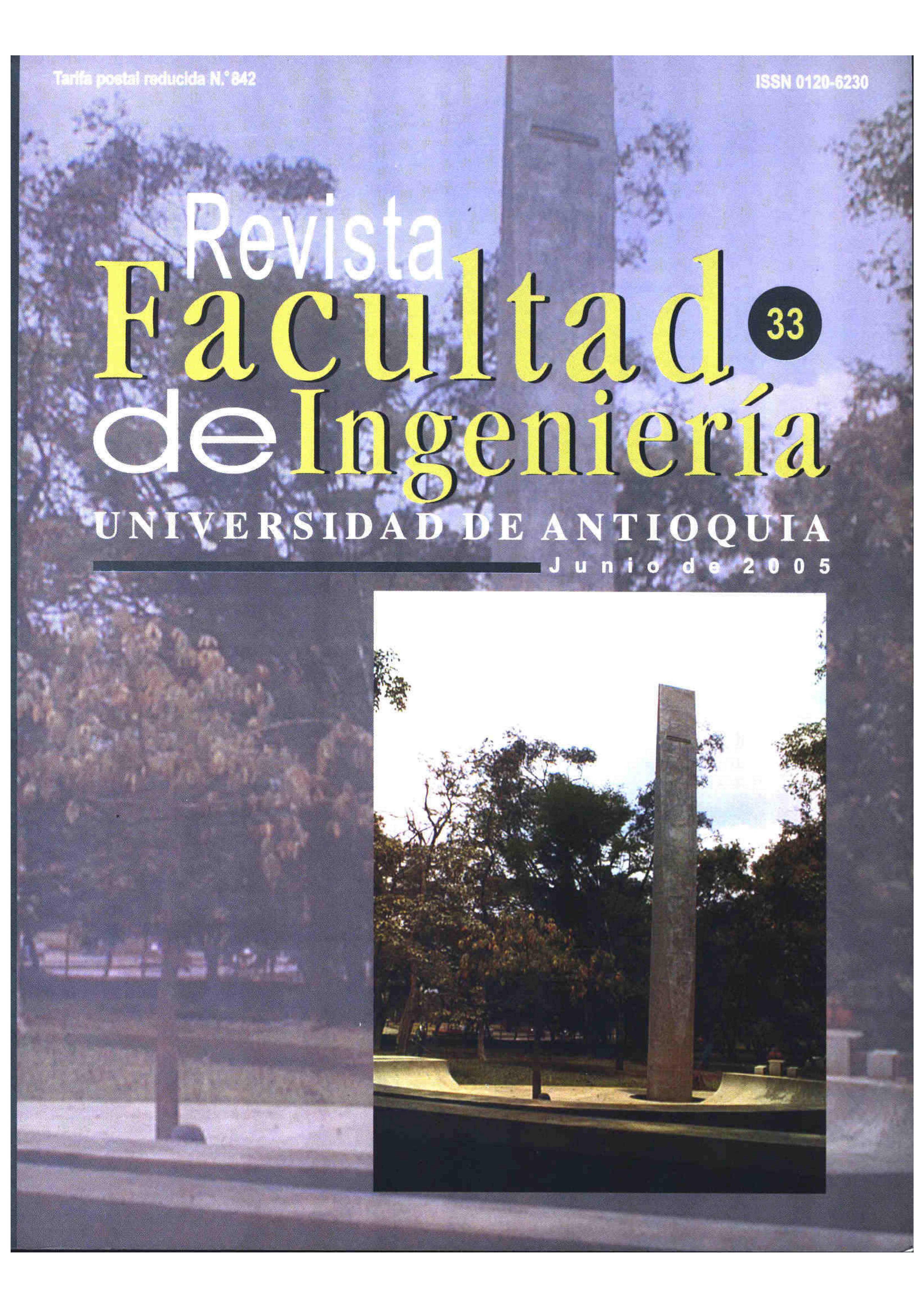Evaluación de la degradación del plaguicida clorpirifos en muestras de suelo utilizando el hongo Phanerochaete chrysosporium
DOI:
https://doi.org/10.17533/udea.redin.344305Palabras clave:
degradación, pesticidas, insecticidas, organofosforados, clorpirifos, Phanerochaete chrysosporium, hongos, ligninolíticos, suelosResumen
Se evaluó la degradación del insecticida clorpirifos en muestras de suelo durante 21 días, utilizando el hongo Phanerochaete chrysosporium. En los ensayos se obtuvieron porcentajes de degradación, en promedio, para las muestras con hongo, de 96,3, 82,4 y 62,2% cuando se trabajaron, respectivamente, con concentraciones iniciales de clorpirifos de 0,95, 5,3 y 9,4 µg/g. Igualmente, los porcentajes de degradación estuvieron acompañados del aumento en la velocidad de degradación, cuando se partió de la concentración inicial de 0,95 µg/g.
Descargas
Citas
Márquez, Sara. Evaluación de algunos efectos de la contaminación por aplicación de lorsban (clorpirifos) en un suelo y un cultivo de kikuyo (Pennisetum clandestinum hochst ex chiov) en el norte antioqueño. Trabajo de grado. Facultad de Ingeniería Universidad de Antioquia. Medellín. 2001. 143 p.
Racke, K. “Environmental fate of chlorpyrifos”. En: Rev. Environmental contamination Toxicology. N.º 131. 1993. pp. 1-154. DOI: https://doi.org/10.1007/978-1-4612-4362-5_1
González, Jaime. Entrevista personal. Laboratorio CIA. Universidad de Antioquia. Medellín. 2003.
Díaz, Abel. Diseño estadístico de experimentos. Editorial Universidad de Antioquia. Medellín. 1999. p. 337.
Montgomery, D. Diseño y análisis de experimentos. Grupo Editorial Iberoamericana. México. 1991. p. 589.
Montgomery, D. et al. Introduction to lineal regresion analisis. Segunda edición John Wiley and Sons. USA. 1992. pp. 56-57.
Johnson, R. y D.Wichern, Applied multivariate statistical analysis. Prentice Hall. New York. 1992. p. 642.
Mardia, KV et al. Multivariate analysis. Academic Press, Duluth. London. 1979.
Neter, J. et al. Applied linear statistical models. Irwin. Boston, USA. 1990.
Lopera, Margarita María. Evaluación de la degradación del plaguicida clorpirifos en muestras de suelo utilizando el hongo Phanerochaete chrysosporium. Tesis para optar a título de magíster en Ingeniería Ambiental. Universidad de Antioquia. Medellín. 2004. p. 127.
Dasappa, S. y R. Oler. R. “Toxicity reduction in contaminated soil bioremediation processes”. En: Water Research. Vol. 25. N.º 9. 1991. pp. 1121-1130. DOI: https://doi.org/10.1016/0043-1354(91)90205-5
Liu, R. et al. “Hydrolysis of chlorpyrifos in natural waters of the chesapeake bay”. En: Chemosphere. Vol. 44. 2001. pp. 1315-1323. DOI: https://doi.org/10.1016/S0045-6535(00)00506-3
Racke, K. et al. “Factors affecting the hydrolytic degradation of chlorpyrifos in soil”. En: Journal Agricultural Food Chemistry. Vol. 44. 1996. pp. 1582-1592. DOI: https://doi.org/10.1021/jf9506141
Murray, R. et al. “Stability of chlorpyrifos for termiticidal control in six australian soils”. En: Journal Food Chemistry. Vol. 49. 2001. pp. 2844-2847. DOI: https://doi.org/10.1021/jf010031t
Bumpus et al. “Fungal degradation of organophosphorous insecticides”. En: Applied Biochemistry and Biotechnology. Vol. 39. N.º 40. 1993. pp. 715-725. DOI: https://doi.org/10.1007/BF02919030
Mougin, C. et al. “Enhaced mineralization of lindane in soils supplemented with the white rot basidiomycete Phanerochaete chrysosporium”. En: Soil Biology Biochemistry. Vol. 29. N.º 9-10. 1997. pp. 1321-1324. DOI: https://doi.org/10.1016/S0038-0717(97)00060-6
Adam, T. y M. Wainwright. “Growth of P .chrysosporium in soil and its ability to degrade the fungicide benomyl”. En: Bioresource Technology. N.º 49. 1994. pp. 197-2001. DOI: https://doi.org/10.1016/0960-8524(94)90039-6
Pointing, S. “Feasibility of remediation by white - rot fungi”. En: Applied Microbiology and Biotechnology. 2001. 25 p.
Kohler, A. et al. “Extracellular ligninase of P. chrysosporium bursdall has no role in degradation of DDT”. En: Applied Microbiology Biotechnology. Vol. 29. 1988. pp. 618-620. DOI: https://doi.org/10.1007/BF00260994
Kennedy, D. et al. “Comparative biodegradation of alkyl halide insecticides by the white rot fungus, P. chrysosporium (bkmf-1767)”. En: Applied and Environmental Microbiology. Agosto. 1990. pp. 2347-2353. DOI: https://doi.org/10.1128/aem.56.8.2347-2353.1990
Kullman, S. y F. Matsumura. En: “Metabolic pathways utilized by Phanerochaete chrysosporium for degradation of the cyclodiene pesticide endusulfan”. En: Applied and Environmental Microbiology. Febrero. 1996. pp. 593-600. DOI: https://doi.org/10.1128/aem.62.2.593-600.1996
Valli, K. et al. “Degradation of the 2, 7- dichlorodibenzop dioxin by the lignin degrade basidiomycete p. chrysosporiu”. En: Journal Bacteriology. Vol. 174. 1992. pp. 2131-2137. DOI: https://doi.org/10.1128/jb.174.7.2131-2137.1992
Descargas
Publicado
Cómo citar
Número
Sección
Licencia
Los artículos disponibles en la Revista Facultad de Ingeniería, Universidad de Antioquia están bajo la licencia Creative Commons Attribution BY-NC-SA 4.0.
Eres libre de:
Compartir — copiar y redistribuir el material en cualquier medio o formato
Adaptar : remezclar, transformar y construir sobre el material.
Bajo los siguientes términos:
Reconocimiento : debe otorgar el crédito correspondiente , proporcionar un enlace a la licencia e indicar si se realizaron cambios . Puede hacerlo de cualquier manera razonable, pero no de ninguna manera que sugiera que el licenciante lo respalda a usted o su uso.
No comercial : no puede utilizar el material con fines comerciales .
Compartir igual : si remezcla, transforma o construye a partir del material, debe distribuir sus contribuciones bajo la misma licencia que el original.
El material publicado por la revista puede ser distribuido, copiado y exhibido por terceros si se dan los respectivos créditos a la revista, sin ningún costo. No se puede obtener ningún beneficio comercial y las obras derivadas tienen que estar bajo los mismos términos de licencia que el trabajo original.










 Twitter
Twitter